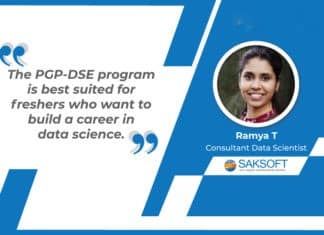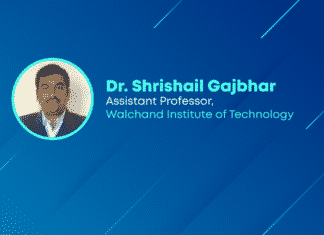
Contributed by: Sunita Gupta
Hi, my name is Sunita Gupta & I am working with American software, consulting, and technology company as a Sr Analytics Manager (IT) for the Customer Experience Team (including Sales Analytics).
After spending almost 20 years in the Industry working extensively on IT Tools to enable the Customer Management & Sales Team, I decided to pursue Data Science as a professional course. I have always been intuitive about facts and figures that are behind a decision or rationale provided to me in both my personal and professional life. This behavior of mine has seen an upward shift now when my teenage daughter makes a demand or an excuse.
In my spare time, I prefer to spend it with me and myself with music in the background or will prefer to travel to mountains.
Before I joined the course, I was enjoying my off-work hours and weekends with my family. Professionally I was working primarily to enable Descriptive Analytics for my Business Partners and Leadership team. During those times, I was partnering with our Data Science team to build a Prescriptive Analytics Use Case to optimize the pricing model. That kicked off my interest in the subject of Data Science.
For the past two years, our CFO and Sales Team was facing issues with getting a lineage between Sales Funnel and Actual Customer Order (Converted Funnel). CFOs were using our Funnel to project Revenue for future quarters, which didn’t prove accurate because we had multiple channels to get a Customer Order.
As part of the Data & Analytics Team, we were constantly getting requests to provide reports to the Business groups to help recon the accuracy of Revenue Forecasts based on Funnel and Actual Customer Orders that didn’t have a Funnel attached to them.
Since Order is a confirmed source of revenue, the company couldn’t get a projected view of Revenue because more than 80% of the orders were coming through channels that are not digitally linked with the Funnel Management System. This was posing a lot of challenges for accurately providing our Annual Commitments to Investors and Market. Also, the revenue collections and resources could not be planned because of inaccurate projections.
The key problem was the missing lineage. To solve the lineage issue, we used 2 techniques primarily to build a solution:
- Descriptive Analytics was at the core:
- An extensive work went into data exploration which demonstrated the reasons and magnitude of missing lineage and its impact on forecasting. This itself was a key step to bring out the behavioral change in the people who were responsible to ensure linkage is maintained in the data.
- Machine Learning Algorithm:
- Extended data exploration to find patterns in our Funnel and Customer Order. The orders that were linked were used as a Train Data to identify the key features that are found consistent on Funnel and Orders to provide recommendations to the leadership team for missing linkage orders. After approving the Lineage recommendations, the system was updated to provide Value Metrics of Funnel Conversions.
- The improved Funnel Conversion was used to consistently re-train the model so it became more reliable to provide Funnel Conversion Probability.
The data was analyzed on multiple dimensions:
- Over-time
- By Industry of Operations
- By Region
- By Customers
- By Sales Channel
Below observations came out of our analysis:
- About 80%-85% of our Customer Orders were missing the Funnel Linkage over the period of analysis
- Few Sales Channels were showing 100% miss like Sales through Distributors.
- Following the Funnel Process was not mandatory for Low value Sales (low value was pre- defined) which was contributing to almost 25% of the missing lineage.
- Hospitality Industry had about 80% missing lineage as their orders are primarily low value (as per the thresholds)
- APAC Region was contributing to 60% of the defect (missing lineage)
- Global Customers were showing the highest miss in each Category.
Based on the observations and improvement observed after training the model, below solutions were recommended:
- An E2E Sales process for Distributors
- Implementing Digital Solutions in countries where non-advocated systems were being used for Sales.
- Analyzing the impacts of exempting low-value Sales on the overall Revenue Number and redefining the value and governance process around it.
- Modifying the process of booking Sales in Hospitality Industry so that multiple low value orders (Outlet level Orders) could be combined into one (Customer Level Order) and then managing child Outlet Order for tracking shipments.
It took almost 1.5 years for the company to make the transformations based on the recommendations. However, the results were promising. Below are the stats for 2019 (first implementation) and 2020.
As can be observed in the over time charts below:
2019: Reached a tipping point in Aug when the transformations efforts started showing positive results
2020: Consistent improvement observed overtime as more and more rollouts happened of the recommended approach
A consolidated view of trends over time. Dec 2019 and Sept 2020 saw some deviations because of increased Sales pressure due to Company’s aggressive Targets.
This was my first initiative towards applying Data Science to quantify a business problem and drive changing behavior. It was very much appreciated by the business and the CFO Organization in particular.
On my personal front, this provided me with the confidence to use the data generated by 100s of transaction systems and show the real picture even if it highlights defects in the business process. I learnt and realized that unless data tells the story, Business Transformations cannot happen which are necessary for the company’s top line.
If you wish to learn such concepts and implement them at work, enroll with Great learning’s Data Science and Business Analytics Course and upskill today.







